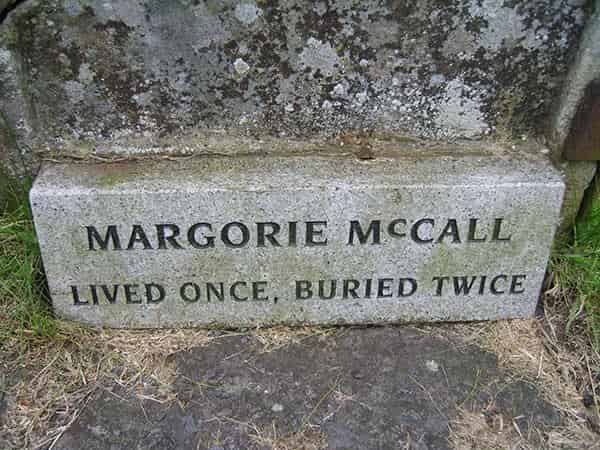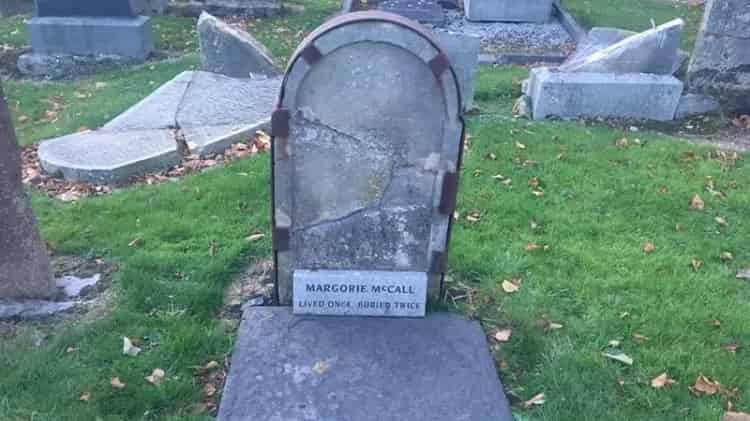The Legend of Margorie McCall: The Woman Who Lived Twice

Margorie McCall’s story has captured the imagination of many, blending history, legend, and the eerie appeal of the supernatural. Known as “The Woman Who Lived Twice,” her tale has been passed down through generations, shrouded in mystery. It has become one of the most famous graveyard legends in Ireland, and it continues to fascinate people worldwide.
Who Was Margorie McCall?
Margorie McCall lived in Lurgan, County Armagh, Ireland, during the early 18th century. The details of her life are largely lost to time, but she became a local legend not because of her life, but because of her supposed death. The tale begins when Margorie fell gravely ill and, despite the best efforts of those around her, was pronounced dead. As per custom, her body was swiftly prepared for burial.
At the time, Margorie wore a valuable wedding ring, which her grieving family left on her finger. Whether it was out of reverence or the inability to remove the ring from her swollen finger, the piece of jewelry remained on her as she was buried in the Shankill Graveyard.
The Robbers’ Mistake
Margorie’s burial might have been the end of her story, but local grave robbers had other plans. A valuable ring left unattended on a buried woman was too tempting an opportunity to miss. Later that night, they descended upon the graveyard, dug up her coffin, and tried to steal the ring.
To their frustration, the robbers couldn’t remove the ring from Margorie’s finger. Desperate, they decided to cut off her finger. However, as they attempted to sever her finger, something unbelievable happened: Margorie woke up. Whether she had been in a coma or suffered from a medical condition that made her appear dead, she startled awake just as her ring was being stolen. The shock of her sudden resurrection terrified the thieves, who fled in terror, leaving Margorie to emerge from her own grave.
A Return from the Dead
Margorie, confused but alive, made her way back to her home. When she knocked on the door, her husband, John McCall, answered. Seeing his wife, who he had just buried, standing before him was too much for John, and he reportedly collapsed and died from shock. The tale goes that Margorie lived on for many years after this miraculous resurrection, eventually passing away for good and being buried in the same graveyard.

The Legend’s Legacy
While the details of Margorie McCall’s life and death remain murky, her tombstone in Shankill Graveyard bears the inscription, “Lived Once, Buried Twice.” This epitaph serves as a reminder of her incredible story and has contributed to the lore surrounding her name. Whether Margorie truly experienced resurrection or if the story has been embellished over the centuries, her legend endures, drawing visitors to her grave even today.
Medical Explanation Behind Margorie’s “Death”
The story of Margorie McCall may seem like pure folklore, but there could be a medical explanation for what happened. During the 18th century, medical knowledge was limited, and it was not uncommon for people to be mistakenly declared dead. Some historians speculate that Margorie may have suffered from a condition like catalepsy, which causes a person to appear lifeless due to a temporary cessation of movement and a reduced heart rate. In the absence of modern medical tools to detect such conditions, it’s possible that Margorie was mistakenly buried alive.
Margorie McCall in Popular Culture
Margorie McCall’s story has inspired countless retellings over the centuries. It has become a staple of ghost stories and Irish folklore. The chilling nature of being buried alive, coupled with the twist of her miraculous survival, continues to capture the imagination of storytellers. Her legend has even influenced modern media, appearing in various TV shows, books, and folklore anthologies.
The Grave as a Tourist Attraction
Today, Margorie McCall’s grave remains a popular tourist attraction. Visitors come to Shankill Graveyard not only for the historic significance of the site but also to experience the eerie atmosphere that her tale evokes. The grave itself, marked with its famous inscription, serves as a physical reminder of a story that has refused to die, much like Margorie herself.
The story of Margorie McCall is a captivating blend of history, folklore, and the human fascination with life after death. Whether she truly “lived twice” or her tale has been exaggerated through the years, Margorie’s legend remains one of Ireland’s most intriguing and enduring stories. Her grave, marked with the enigmatic epitaph, continues to attract those who seek to uncover the truth behind “The Woman Who Lived Twice.”
FAQ: Margorie McCall Story
1. Who was Margorie McCall?
Margorie McCall was a woman from Lurgan, County Armagh, Ireland, who is known for the legend that she was buried alive and later resurrected after grave robbers attempted to steal a valuable ring from her.
2. What is the story of Margorie McCall?
The legend goes that Margorie was mistakenly declared dead, buried with a valuable ring, and later revived when grave robbers tried to steal the ring by cutting off her finger. She woke up, causing the thieves to flee, and she then returned home alive.
3. Is the story of Margorie McCall true?
While Margorie McCall’s story is part of local folklore and her grave marker bears the inscription “Lived Once, Buried Twice,” it is unclear whether the story is historically accurate or simply a legend that evolved over time.
4. Where is Margorie McCall buried?
Margorie McCall is buried in Shankill Graveyard in Lurgan, County Armagh, Ireland. Her grave is marked with the famous epitaph “Lived Once, Buried Twice.”
5. What does the phrase “Lived Once, Buried Twice” mean?
This epitaph refers to the legend that Margorie was buried alive after being mistakenly pronounced dead. She supposedly revived and returned to her family, only to be buried for real years later when she actually passed away.
6. Why did grave robbers target Margorie McCall’s grave?
The grave robbers were reportedly after a valuable ring that was left on Margorie’s finger when she was buried. At the time, grave robbing was a common practice, especially if it was believed the deceased were buried with valuables.
7. Could Margorie McCall have suffered from a medical condition?
Some believe Margorie may have suffered from catalepsy, a condition that causes the body to become rigid and unresponsive, making it appear as though the person has died. Given the limited medical knowledge of the time, it’s possible Margorie was mistakenly declared dead.
8. What is the significance of Margorie McCall’s story in Irish folklore?
Margorie McCall’s story is one of Ireland’s most famous graveyard legends, symbolizing the fear of being buried alive, a common concern in the 18th century. Her tale has been passed down through generations and continues to captivate people today.
9. Is Margorie McCall’s grave a tourist attraction?
Yes, her grave in Shankill Graveyard has become a popular tourist destination. Visitors come to see the famous tombstone and experience the eerie legend firsthand.
10. Has Margorie McCall’s story appeared in popular culture?
Yes, her story has inspired many retellings in ghost stories, folklore collections, TV shows, and books. It remains a compelling narrative in both local Irish culture and international storytelling.
